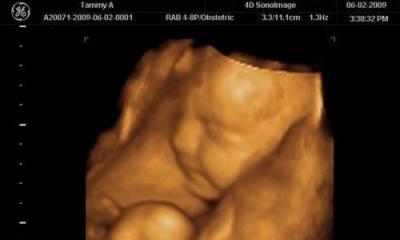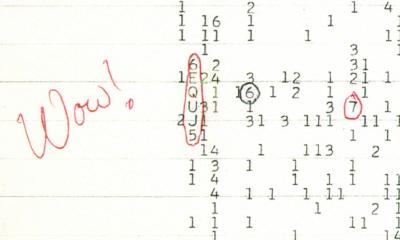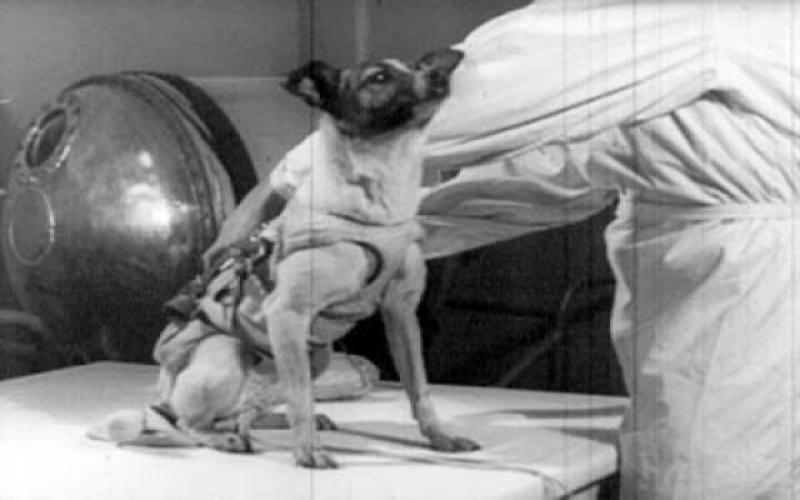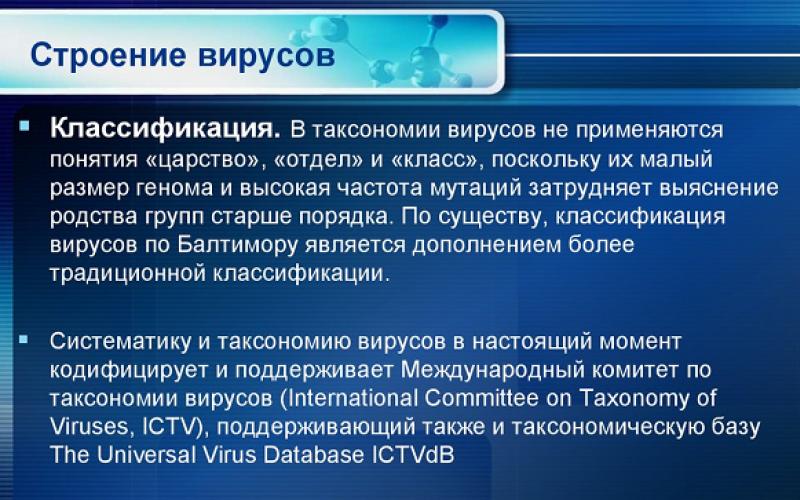On August 15, 1977, astronomer Jerry Ehman was reviewing records from the Ohio University radio telescope, hoping to find something meaningful. In what has become one of the most famous moments in astronomy, he noticed on a printout a sequence of six characters - 6EQUJ5 - that attracted attention.
Struck by how closely the characteristics of the received signal matched the expected characteristics of the interstellar signal, Eyman circled the corresponding group of characters on the printout and signed "Wow!" ("Wow!"). This signature gave the signal its name.
Radio telescope "Big Ear"

Ohio University's Big Ear radio telescope was, well, huge. He is no more. The structure was dismantled in 1998, and the vacated area replenished the fields of the local golf club. The main feature of the radio telescope was a huge structure on the surface of the earth 150 by 85 meters, oriented in the direction of the North and occupying about three football fields. Approximately in the middle of the structure there was a pair of receiving sockets oriented to the South. The funnels were at the focus of a parabolic reflector measuring 110 meters by 21 meters, which stood south of the funnels like a giant movie screen. This parabola received a signal reflected from a flat screen measuring 104 by 30 meters, which stood in the northern part of the structure, behind the receiving bells, and had an adjustable slope. As the Earth rotated, the "Big Ear" combed space in a single line. Every few days they changed the angle of the flat screen, changing the direction of the search. The maximum screen rotation angle was 50°. The Big Ear design was called the Kraus project, after its designer, Dr. John Kraus. The cost of the project is $250,000, including a $71,000 grant from the National Science Foundation. The whole structure was built by the hands of students.

In 1980, the Big Ear was given options that would have come in very handy in 1977, when the WOW signal was discovered. Receiving sockets got the ability to change the angle along the West-East axis. Such an improvement made it possible to compensate for the rotation of the Earth and fix the observation in the direction of interest. Since there was no such option in 1977, the radio telescope passed any point in the sky along with the rotation of the Earth in 72 seconds. For this reason, the WOW signal has a duration of 72 seconds.
In 1977, there was still no computer processing of the signals received by the Big Ear. The information received was printed on paper and viewed by volunteers. This is exactly what Jerry Ehman did when he made his famous WOW!
Printout transcript

circled code 6EQUJ5 describes the change in the intensity of the received signal over time. Each line on the printout corresponded to a 12-second interval (10 seconds of actual listening to the air and 2 seconds of subsequent computer processing). In order to save space on the printout, the intensities were encoded with alphanumeric characters: a space meant an intensity from 0 to 0.999..; figures 1-9 - intensity from the corresponding intervals from 1.000 to 9.999…; intensity, starting from 10.0, was coded with letters (so, "A" meant intensity from 10.0 to 10.999 ..., "B" - from 11.0 to 11.999 ..., etc.). The letter "U" (intensity between 30.0 and 30.999...) was encountered only once during the entire operation of the radio telescope. Intensities in this case are dimensionless signal-to-noise ratios; the noise intensity in each frequency band was taken as the average value over the previous few minutes.
The signal width was no more than 10 kHz (since each column on the printout corresponded to a 10 kHz bandwidth, and the signal is present in only one single column). Various methods for determining the frequency of the signal gave two values: 1420.356 MHz (J. D. Kraus) and 1420.456 MHz (J. R. Ehman), both within 50 kHz of the frequency of the neutral hydrogen radio link (1420.406 MHz, or 21 cm.)
The signal strength was represented by the numbers 0-9 and the letters A-Z, on a 36-point intensity scale, rising 6EQ and falling UJ5, a near-perfect bell ring, lasting 72 seconds.
And what's interesting there?
You may be interested to know what was interesting in the WOW signal? Many different types of radio signals continuously traverse space. What was special about the WOW signal? The answer lies in the frequency of this signal. To understand the significance of the frequency of the WOW signal, one must be reminded of the space radio environment.
There are different types of radio noise. The background component of the radio noise is the remnant of the Big Bang, the value of which is about 3x Kelvin. That is, by default, the universe cannot be quieter than 3 Kelvin. Below a frequency of 1 GHz, there is a lot of galactic noise, which is difficult for a man-made signal to compete with. At frequencies above 10 GHz, there is a lot of so-called quantum noise. Thus, the relatively quiet window is between 1 GHz and 10 GHz.
In addition to the physical existence of various noises, the influence of the Earth's atmosphere should be taken into account. It reflects some noise and absorbs some. There are two frequency windows in the atmosphere that are more or less transparent to electromagnetic radiation. The first is the visible spectrum, so our eyes have learned to see it in the process of evolution. The second, coincidentally, is precisely the frequencies between 1 GHz and 10 GHz.
In place of an intelligent alien who wants to send a signal to other civilizations, two points should be taken into account. The first is the broadcast of the signal in the frequency band of the least noise. The second is its clear identification as artificially created. Thus, you would probably want to send a signal at an atmosphere-penetrating frequency where there is a minimum of competing background noise and, for added measure, at a frequency close to that of hydrogen, the most abundant element in the universe.
Interstellar hydrogen radiates at a frequency of 1.42 GHz. This happens during the transition between two sublevels of the hyperfine splitting of the ground state of hydrogen. The incomprehensibly large amount of interstellar hydrogen means that this radiation can be heard by a sensitive radio tuned to 1.42 GHz. Close to this frequency, interstellar hydroxyl (OH) radiates steadily, its frequency is 1.66 GHz. We see these bursts on the recording equipment. They will be noticeable in whatever direction of outer space we point the radio telescope.
Astronomers refer to this frequency band as the "Waterhole". First, hydrogen and hydroxyl are breakdown products of water, the best environment for life. Secondly, these frequencies are universal and will be recognized by any civilizations in the universe. Like the water coolers in an office gathering around them for a drink, the "Waterhole" frequency band will be where interstellar communities will meet and greet each other.
The WOW signal was received at the expected water hole frequency of 1.42 GHz. This was precisely the breakthrough of an intelligent interplanetary signal. If humans were ever to receive radio contact from aliens, the WOW signal is exactly what one would expect to hear.
The WOW signal is attractive in that it does not fit any explanation. One of the reasons this frequency band is protected. No one on Earth works in these frequencies. We know that the signal is not received from a passing air or spacecraft. Because the signal is fixed from a fixed point in the sky. In that direction, there are no planets or asteroids that could reflect the signal back to Earth. Any space debris capable of reflecting would need to be stationary relative to Big Ear and not spinning, which is unlikely. Even complex astronomical effects such as gravitational lensing and interstellar twinkling (like what we see visually when looking at stars) have technical causes that make them very weak candidates for explaining the WOW signal.
Signal source position

Alien intelligence is still a candidate for explaining the WOW signal. But there is no evidence for this. A stronger candidate is a much more vague explanation of an interstellar radio source of unknown origin. Meanwhile, the famous printout, marked by Jerry Ehman, rests in the archives of the Ohio Historical Society. In this day and age, when a huge number of amateurs are churning out fables, the WOW signal is a true artifact, with a practical potential unlike anything else in the history of mankind. Perhaps this is one of the most exciting mysteries we have.
www.youtube.com/watch?feature=player_detailpage&..








